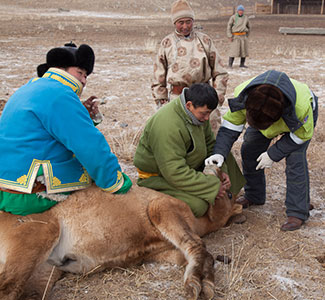Research improves health among Mongolian livestock herders

Photo courtesy of Dr. Gregory Gray
Mongolian and U.S. researchers were trained with Fogarty
support to study animal-human disease transmission among
nomadic livestock herders.
Mongolia’s economy has undergone rapid changes in the past few decades with marked increases in livestock production of sheep, goats, camels, horses and cattle. As the normally pastoral populations have begun migrating to urban areas, humans and animals are coming into closer contact, increasing the spread of disease.
With limited research and diagnostic capacity, Mongolia had difficulty responding to zoonotic diseases. A Fogarty research training grant to Duke University’s Dr. Gregory Gray supported a five-year effort to change that. Gray recruited a dozen scientists for training in One Health concepts and innovative diagnostic, epidemiologic and analytical research methods. Mongolian and U.S. scholars spent several months at Duke learning a multidisciplinary approach to research that includes aspects of public health, agriculture, environmental engineering and veterinary medicine. Trainees also learned about responsible research conduct - including human subject protection and the informed consent process - and received anti-sexual harassment instruction.
Then the three-person teams of Mongolian and American scholars designed projects, moved them through ethical reviews, developed budgets and bought supplies. During the process, Mongolian trainees improved their English language proficiency and presentation skills. Gray and Dr. Battsetseg Gonchigoo, of Mongolia’s Institute of Veterinary Medicine and others provided mentorship throughout, as the teams conducted their field work, analyzed results, prepared publications and wrote grant applications. The research teams studied various aspects of animal-human interactions over six years and published more than 20 scientific articles with their findings.
Some of the results were surprising, Gray noted. “For instance, we found the first evidence that strains of influenza A virus that commonly infect horses were also likely infecting camels. And we found an unusual rickettsial pathogen in ticks, which might explain some of their tick-bite associated deaths among humans.”
Mongolia is home to about 3 million people who co-exist with 50 million livestock, on which they rely for critical resources such as meat and milk products, leather and hides, wool, cashmere, and other goods needed for household sustenance, barter and sale. To better understand the types of animal-human contact, hygiene practices and knowledge of zoonotic diseases, one research team developed and conducted a survey of Mongolian herding households.
Participants reported the contact they had with animals, for instance during birthing, milking or slaughtering. Other risks tallied include handling manure used for fuel. While the majority said they washed their hands after animal contact, most did not after defecation or urination. Less than half the respondents had access to an improved drinking water source and about 50% reported practicing open defecation. Most households had knowledge of disease transmission from animals to humans but far fewer understood the reverse.
Research teams also studied tick-born infections, demonstrating they are common among domestic animals, small wild mammals and herders. Others focused on mosquito-borne infections that can cause diseases such as encephalitis and West Nile Virus in both animals and humans. Another group used rapid diagnostics to look for influenza A and B, suggesting the tests may be an effective tool for rural practitioners. Other trainees investigated the prevalence and risk factors for intestinal parasites.
Findings from Gray’s teams have helped shape Mongolian public health strategies. Researchers developed flyers, videos and an educational handbook for herder safety, encouraging influenza vaccines and the use of personal protective equipment. Text messaging might be considered for future outreach, Gray noted, since the survey found solar-power charged cellphones were present in all herder households.
Gray hopes the discoveries made in Mongolia can help to reduce the burden of zoonotic diseases among pastoral people worldwide. “If we can anticipate when microbiological threats are jumping back and forth between animals and humans before they take hold and become very transmittable, then we can design mitigation strategies,” said Gray. “What impacts people in the developing world today can be a problem in our very own back yard tomorrow, so the work that Fogarty does in global health is extremely important in protecting U.S. citizens and their animals.”
Adapted from the November / December 2020 Global Health Matters article
Research improves health among Mongolian livestock herders.
More Information
Related World Regions / Countries
Related Global Health Research Topics